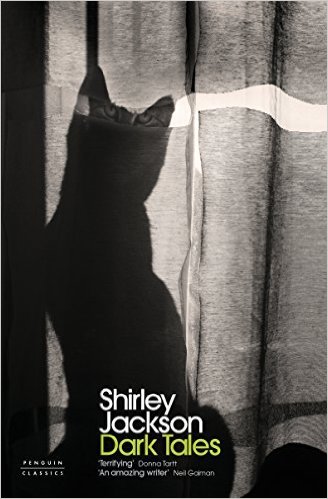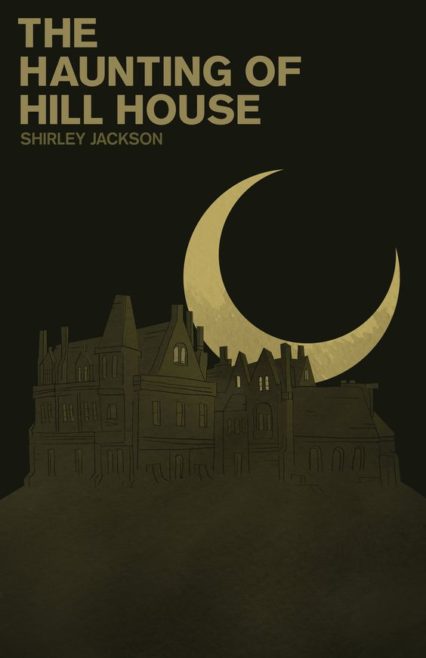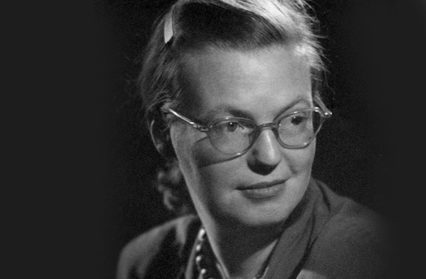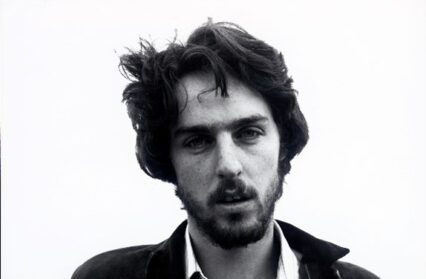Max Ashworth writes about the new biography of Shirley Jackson, in an age when serious reappraisal of her work is underway by the mainstream; in addition to Ruth Franklin’s new biography come reprints from Penguin Classics of Jackson’s complete works, plus a Hollywood adaptation of one of the Jackson’s masterpieces, We Have Always Lived in the Castle.
In general we are reminded that the word ‘heimlich’ is not unambiguous, but belongs to two sets of ideas, which, without being contradictory, are yet very different; on the one hand it means familiar and agreeable, and on the other, what is concealed and kept out of sight . . . everything is unheimlich that ought to have remained secret and hidden but has come to light.
(Sigmund Freud, ‘The Uncanny’ p. 224-5)
After his work on West Side Story, and before he gave his attention to The Sound of Music, director Robert Wise took on yet one more film genre with The Haunting. Wise addressed the problem of the Uncanny with some real insight when he claimed that the novelist (Jackson had already been nominated for The National Book Award) “writes just on the edge of reality and unreality.” The Uncanny is crucial to Jackson’s writing life, and correctly occupies a central position to the biography under review.
Like The Catcher in the Rye, most Americans born around the 30s, 40s and 50s read Jackson’s seminal short story The Lottery at high school or college. It is sad to learn via my arbitrary canvass of well-read friends that, other than The Haunting of Hill House, and the subsequent ubiquitous Christmas Eve movie adaptation, The Haunting, (and its awful 1990’s remake), her back catalogue, Jackson’s many dozens of short stories, and two entertaining memoirs of domestic life, were tragically unknown to most.
 Penguin Classics in 2014 re-issued her six novels, stories and two memoirs, and this year have reprinted them again, with even more beautifully artistic and disturbing covers, and cogent introductions and afterwords. Superlative quotes from Donna Tartt, Neil Gaiman, Tom Stoppard, A.N. Homes, Paul Theroux, and Joyce Carol Oates – to name just a few – feature proudly on the covers. Penguin Classics have also published this year Let Me Tell You, a new collection of unpublished stories, essays and lectures.
Penguin Classics in 2014 re-issued her six novels, stories and two memoirs, and this year have reprinted them again, with even more beautifully artistic and disturbing covers, and cogent introductions and afterwords. Superlative quotes from Donna Tartt, Neil Gaiman, Tom Stoppard, A.N. Homes, Paul Theroux, and Joyce Carol Oates – to name just a few – feature proudly on the covers. Penguin Classics have also published this year Let Me Tell You, a new collection of unpublished stories, essays and lectures.
2015 marked 50 years since Jackson’s death. December 14th 2016 was the 100th anniversary of her birth. Unlike Oppenheimer, Jackson’s first biographer, Ruth Franklin timed her biography pertinently well. This was most fortuitous for Franklin, as she has been working on this masterpiece since 2010, when Jackson’s books were largely unavailable in retail bookshops, and therefore expensive online.
Why Jackson did not receive this attention during her lifetime is a theme we shall soon explore. Jackson died at the age of 48. This year a ‘big budget’ Michael Douglas-produced film adaptation of We Have Always Lived in the Castle will be released, and coincide with the novel’s 65th anniversary. And Hangsaman, her beguiling second novel, is 75 this year. I am ambivalent about a film adaptation – as like Hangsaman, Jackson’s books are so internal as to be almost unfaithfully filmable.
Last month I bought a CD, at some expense, of Jackson reading The Lottery and The Daemon Lover. I didn’t know what to expect – most photos of her feature a scowling and dowdy woman wearing harlequin glasses and flowery dresses or lumberjack shirts that do not suit her, but she obviously held great affection for her family, and was apparently riotous company, so I wasn’t sure how her voice would sound.
It transpired that what I heard was the oddly unaffected timbre of a woman seemingly trying to disguise southern Gothic roots (which she didn’t have, raised in an affluent Californian suburb) and with the quiet ferocity and slow urgency (oxymorons aside), and the kind of unexpected emphasis of a Dickens recital (review the heavy underlinings and added stresses in his reading-tour copy of A Christmas Carol). I was distraught to learn I had exhausted her oeuvre, but I am re-reading them all again as Jackson would have read them. (Jackson frequently read her work aloud, and if her husband was home, she would be banished from sharing his study and take the typewriter to the kitchen table, where she would be harassed by her children.)
Ruth Franklin, like Jackson, is an excellent writer indeed. As well as writing for the New Yorker (who published The Lottery), she has also been a frequent contributor to Harper’s, and published the text, A Thousand Darknesses: Lies and Truth in Holocaust Fiction. Her credentials and list of achievements are staggering. Franklin, a one-time resident of Washington DC, had thankfully not an incommutable or insurmountable journey to access Jackson’s archive at the Library of Congress. Now, at one time last year I considered a postgraduate proposal on Shirley Jackson’s life and work, and she would be my confident Mastermind specialist subject, and she is one of the few authors I have read in their entirety, so I arrogantly didn’t expect to learn anything new from this work; and reading a second biography is naturally going to provide certain tautologies.
However, Franklin’s research and doggedness, and sheer admiration for her subject, certainly threw up many new and fascinating anecdotes, and pieces of wonderfully fresh and insightful information. (The story goes that Jackson’s husband, Stanley Edgar Hyman, a respected literary critic, received a communication from the Library of Congress asking for his notes, letters, and papers for an archive of his which they were planning. The communication had a postscript: “Oh, we’d also like your wife’s, as well.” Hyman treated Jackson badly, was jealous of her talent, and denigrated her at most possible moments, so it is maybe satisfying to learn that it is his work that is now out of print). In keeping with Jackson’s playful self-mythologising and her ‘look over there’ sleight of hand, Franklin avoids gossip but also challenges apocrypha, notably about Jackson’s ‘intimate encounter’ with Dylan Thomas, and finds mention of some of this encounter in Jackson’s short stories, “The Beautiful Stranger,” and “Pillar of Salt,” and “A Visit: For Dylan Thomas,” reprinted as “The Lovely House,” in which the main characters, all Margarets, a fictional alter-ego, long for domestic release through mental liberation, escapism, or via an enigmatic stranger.
In addition, Franklin’s biography is beautifully laid out, with facsimiles of hand-written letters and typed correspondences – fans love procedural details, and Jackson hand-wrote almost illegibly and, when at the typewriter, used yellow legal paper and never used capital letters. It is also refreshing that the centre pages do not contain the ubiquitous photographs (and let’s face it, don’t we all go to the photos first?), but are here relevantly interspersed throughout the text.
The biography is presented in standard chronological form, and Franklin devotes a chapter to each novel and Jackson’s personal and intellectual life, and her psychological and domestic struggles while writing them. A parsimony of the imagination means that you tend to assume that everyone else thinks and feels exactly the same way you do. So it came as an unedifying surprise to learn from Franklin’s well-discovered reviews that Jackson’s early novels split the room. Reviewers either praised The Road Through the Wall, Hangsaman, The Bird’s Nest and The Sundial, for their “strangeness”, or, strangely, criticised them for their, um, “strangeness”. Jackson, as described in Franklin’s biography, and hopefully this review, just could not win. These aforementioned books are indeed, um, strange. Furthermore, to Franklin, and this reader, herein lies their uniqueness, their imaginative daring and unusual atmospheres, and their refusal to conform to the cosiness and conventions of genre; but I am also here to tell you now that they are utterly hilarious. The Sundial, despite its unlikely scenario and promise of an ensuing apocalypse, is the funniest book I have read. Maybe this is what baffled reviewers. Like, how can such a disturbing and psychologically suspenseful and portentous novel be allowed to be so funny, and get away with it?
Jackson rarely permitted an interview, but when pressed, merely gave scant biographical details – a lot of which was playfully untrue – and refused to discuss her work (and I don’t have the space here to get all Death of the Author on you, but wasn’t she half right? Surely, the joy of the biography is to shed further light, rather than to over-intellectualise and narcissistically impose our own world-view upon the text and author’s intentions?) She did not try to quell the rising tide and provide explanations upon “What The Lottery was about.” It is apparent to Franklin, and me, that the theme of arbitrary and organised events and the subsequent and inevitable capacity for mob violence was clear. And it goes without saying, the undertow that ritualistic atavism, i.e., anti-Semitism – Jackson’s husband was Jewish, and even post-war this didn’t go down well locally – could restore a kind of medieval sense of order, and that Jackson was shocked that her readers focussed on the horrific final paragraphs and missed the clear allegory of the story. (When discussing Thomas Tryon’s Harvest Home and Anthony Shaffer’s The Wicker Man, I am of course impelled to always use The Lottery in the same sentence.)
Imagine being a mother, housewife, and feminist in the post-war era – where shell-shocked men were returning home and taking back prior jobs from their womenfolk – and at aged just over 30 and having your first short story published in The New Yorker (it took Salinger years of attempts to get published there). It’s hard to look back 70 years and be astonished by what an achievement that was. So, imagine being informed by that revered publication that due to their unmitigated horror upon reading The Lottery, many readers had cancelled their subscriptions, complaints were through the roof, and that Jackson was receiving death threats. I wish I were making this up. The American Dream, it appeared, only applied to men. Brendan Gill’s section on Jackson in his gossipy memoir Here at the New Yorker begins, “Shirley Jackson Hyman wrote under her maiden name.” Not incidentally, but when Jackson was driven to hospital by taxi (unlike Jackson, her husband never learned to drive) to deliver her third child, the nurse asked for her occupation, to which Jackson replied, “Writer.” There was a long pause. “Um,” said the nurse. “I’m just going to write down, ‘housewife’.”
The ‘pram in the hallway’ is the oft-quoted explanation that domesticity and parenthood de-rails creativity [After JG Ballard’s wife suddenly died, he had to raise three teenage girls, and write professionally in the meantime. When asked how he dealt with this sudden change to his life, he replied, “A shot of whiskey at midday, and another one every hour.”] Jackson never drank around the children, but who can blame her heavily imbibing once the ‘demons’ were tucked in?
Judy Oppenheimer wrote a decent biography in 1988: Private Demons – The Life of Shirley Jackson, which I also recommend. My one caveat is that, like Jackson’s homely memoirs (Life Among the Savages and Raising Demons), it didn’t, for me, enter into enough critical discussion of the work that these ‘Private Demons’ and ‘Savages’ helped inspire, create, and mitigate. Maybe ‘helped’ is the wrong word. Anyway, I am pleased to report that Jackson’s life and fiction are here, in Franklin’s biography, intelligently linked, with a readable and academic tone, and with 100 pages of notes, footnotes, and a comprehensive index, which are a Shirley Jackson nerd’s wet dream.
Unlike Virginia Woolf, Jackson did not have a ‘Room of One’s Own’. And while living in a cramped tenement apartment, and then a 17-room house in rural Vermont, she wrote in her husband’s study while he was teaching at the local university. And in between nappy-changing, shouting at the kids to get out of bed, breakfast, taking them to school, collecting them, pre-dinner cocktails for her husband, dinner, and the little league and weekend kiddie events, she somehow found time to write. And write she did, “Not with a pen, but with a broomstick,” is a famous quote, and one she did nothing to contradict, as she frequently claimed to be a witch. Time Magazine called Jackson, “The Virginia Werewolf of Séance Fiction.” Answers on a postcard please – to Franklin, and to me – if you know what séance fiction means.
 I’m going to jump ahead now to Jackson’s penultimate and most famous novel, The Haunting of Hill House. Now, maybe we didn’t need Freud to explain the dichotomy of heimlich/das unheimlich and the milieu in which this collision would occur. Pre-Freud, the academic proposal was that the complex series of corridors in haunted houses were ‘uterine’ – the house representing a symbolic womb, and escaping from it or perishing inside it represented a metaphoric re-birth, or belated miscarriage. Then, later, haunted houses became symbolic mirrors, reflecting back the inhabitant’s fears, desires, depravities, but not kindnesses. Some argue that the actual physical book of Wuthering Heights itself becomes the haunted house, and Mark Z Danielewski’s resplendent House of Leaves even has a front doorknob on its cover artwork.
I’m going to jump ahead now to Jackson’s penultimate and most famous novel, The Haunting of Hill House. Now, maybe we didn’t need Freud to explain the dichotomy of heimlich/das unheimlich and the milieu in which this collision would occur. Pre-Freud, the academic proposal was that the complex series of corridors in haunted houses were ‘uterine’ – the house representing a symbolic womb, and escaping from it or perishing inside it represented a metaphoric re-birth, or belated miscarriage. Then, later, haunted houses became symbolic mirrors, reflecting back the inhabitant’s fears, desires, depravities, but not kindnesses. Some argue that the actual physical book of Wuthering Heights itself becomes the haunted house, and Mark Z Danielewski’s resplendent House of Leaves even has a front doorknob on its cover artwork.
The term Gothic has evolved since the 1790s, but the one thing to contemporaneously remain is that the definition of the Gothic remains unrealistic, romantic – maybe even quixotic, and expressionistic: the dissolution of the self. I, and Franklin, resist imposing the term ‘Gothic writing’ upon a writer so diverse and often times uncategorisable as Jackson, but Gothic writing still shares a close relation to social fears and taboos, isolationism, and the ignorance of ‘the other’ – some of which the Jackson-Hymans, a ‘modern family’, experienced locally in spades.
Given the recent slew of haunted house movies, and their discouraging hark-backs to repetitious books from the 40s-70s, we are depressingly informed that the house is haunted by a previous inhabitant (usually a young child) who died terribly, usually murdered by a parent (erm, paging Dr. Freud…) and is unable to leave, or move on. Sometimes it’s a malicious ghost, as in The Amityville Horror (“Get out!”). In Richard Matheson’s Hell House, the house absorbs the murderous and sexual depravities and proclivities of its many guests, stores it up like a battery, and then unleashes this evil energy upon future guests, or investigators. However, in Hill House, Jackson explores a fresh idea that a house can be a ‘live organism’, and, exposed to excessive reality, ‘not sane’; born bad (an idea later taken up by Anne Rivers Siddons’ The House Next Door. When that novel begins, the haunted house hasn’t even been built, yet Siddons alas then goes down the dated symbolic mirror route.). So ‘Hill House’ is an architectural bad seed, a building whose conception should, ought, to have been aborted; and here’s the glorious opening paragraph:
No live organism can continue for long to exist sanely under conditions of absolute reality; even larks and katydids are supposed, by some, to dream. Hill House, not sane, stood by itself against its hills, holding darkness within; it had stood so for eighty years and might stand for eighty more. Within, walls continued upright, bricks met neatly, floors were firm, and doors were sensibly shut; silence lay steadily against the wood and stone of Hill House, and whatever walked there, walked alone.
Jackson believed that houses had personalities, and her last three novels feature a house as a looming character. They also represent the feminist theme of the forces that conspire to keep women trapped in the home; like Eleanor, staying in Hill House, like a bad marriage, is less frightening than leaving it. Hill House is a place in which it is both impossible to leave and also impossible to remain. Jackson’s marriage to Hyman was fractious during the writing of Hill House. Hyman was apparently a distant father, pompous, demanding, and a philanderer. All the male characters in Jackson’s novels and many short stories are incompetent, or ineffectual. Either academics, doctors, or intellectuals, or either the smugly aspirational middle class, or the impatiently-waiting-to-inherit progeny.
When Jackson drove her son around Vermont unsuccessfully looking for suitable inspirations for Hill House she later wrote to her mother saying that the local buildings were square and boring and she couldn’t possibly imagine them being haunted. It turned out that the photograph her mother sent her, and which Jackson used, was an imposing Gothic edifice built for a robber baron in 1850s San Francisco. And the architect? Jackson’s great-great grandfather.
It is interesting to deduce from Franklin’s biography and “Savages” and “Raising Demons”, which parts of Jackson’s life she drew from and which she clearly and tellingly omits from her fiction.
Oppenheimer’s biography, with maybe too much information, suggests that Stanley Hyman, her absent-minded and adulterous, student-shagging husband, returned home and to Jackson’s bed because they had such a good sex life. Jackson was also a heavy drinker, used prescription amphetamines to get her through the day and to lose weight (she died morbidly obese), and she was also a heavy smoker. She had four children, and was an excellent pianist. However, in her novels there are very few children, no drug-taking, overt drinking or smoking, no music, and the only one reference to any kind of sexual encounter is when Natalie Waite, heroine, (or victim) of Hangsaman, is molested during a garden party. (Oppenheimer’s sometimes sensational biography suggests that Jackson, when a teenager, was molested by her uncle.)
However, the themes of mental strain and incipient madness (in her final years Jackson became so agoraphobic that she didn’t leave her bedroom for a year); the fetishisation of eating and of food preparation (lively dinner parties were a regular weekly event); and the belief that one could internally effect or regain control of the vagaries of the outside world; all of these, together with her remarkably clever sense of humour, appear regularly.
So, Natalie Waite in Hangsaman goes to college and succumbs to schizophrenia, the many spiteful and cliquey parties and her lecturer’s overt adultery exacerbating her nascent madness. In The Bird’s Nest, it is inferred that a large gaping fissure in the museum office of Elizabeth, the heroine (or victim), is the cause of her psyche to split into three other personalities. Each character in The Sundial is totally barking. Eleanor refuses to accept her psycho-kinesis in Hill House. And Merricat in We Have Always Lived in the Castle is a sociopath, pyromaniac, and murderer. Each character has their own way of coping with the reality of experience versus their inner turmoil. And food features all the time.
Please allow me to impart an excellent anecdote from Donna Tartt’s introduction to The Masterpieces of Shirley Jackson: Jackson’s sister-in-law came for lunch and they both eventually noticed, and sat in silent horror for 30 minutes, as a red liquid dripped from a kitchen cupboard. A child arrived home from school and asked what all the shaking was about and casually and duly opened the cupboard door. A bottle of red wine had fallen over. The point of the story was not that they were shaking in terror over some spilled wine, but that the red stain was wine and not blood. In Jackson’s world, the rational explanation was never the one that jumped to mind first.
As Franklin points out, Jackson is a master at blending the domestic ‘heimlich’ with unspoken and revealed horror, ‘das unheimlich’. In Stephen King’s non-fiction discussion of the horror genre, Danse Macabre, he gives a chapter to Shirley Jackson and her mastery of The Uncanny. (King also dedicated Firestarter to her: “To Shirley Jackson, who never had to raise her voice.”)
She knew that if she asked her husband to take her out to a movie, or out for a ride, or to play gin rummy, he would smile at her and agree; he was always willing to do things to please her, still, after ten years of marriage. An odd thought crossed her mind: she would pick up the heavy glass ashtray and smash her husband over the head with it.
(Shirley Jackson, Dark Tales, 2016)
Some might argue that Jackson shot herself in the foot by writing very lucrative, funny, family stories for women’s magazines. Maybe these diminished respect from readers and critics of her serious fiction. Franklin’s biography firmly says no. It demonstrated a range that most writers would only dream about.
Jackson’s early death was a tragedy and my lachrymose and angry reflections – why are inferior writers (or teams of writers) chucking out three books a year, and why are people buying them? Jackson did not embrace the status quo and discussed uncomfortable and unusual subject matter – and for that, as a mother, home-keeper, writer, and feminist, Franklin is right to say that Jackson was decades ahead of her time. And maybe now we are finally catching up.
Her last novel, We Have Always Lived in the Castle, is not just her best novel, but a crowning achievement in post-war American fiction. Shirley Jackson was an avid reader of Henry James, but, to me, she wrote a better paragraph. To the uninitiated, here is the opening paragraph to We Have Always Lived in the Castle:
My name is Mary Katherine Blackwood. I am eighteen years old, and I live with my sister Constance. I have often thought that with any luck at all I could have been born a werewolf, because the two middle fingers on both my hands are the same length, but I have had to be content with what I had. I dislike washing myself, and dogs, and noise. I like my sister Constance, and Richard Plantagenet, and Amanita phalloides, the death-cap mushroom. Everyone else in my family is dead.
So, to end back on dichotomies: It is an interesting philosophical point – how do we reconcile living in a haunted house, or A Rather Haunted Life? Which truths and which lies do we choose to impart or expunge from conversations with people, friends, relatives, readers and strangers, even future employers? Moreover, how much of our lives do we decide to edit, relay verbatim, and/or embellish when writing serious fiction? BS Johnson believed that you could only write from experience. But personally, and from Franklin’s biography, I think many decide that most of the time it’s a lot more fun to make stuff up, and when writing weird, or psychological, or horror fiction, how much reality must we include, and where does it come from, this ‘reality’? I’m not sure whether I believe in writing for therapy, but for two decades Jackson competently kept many plates spinning, and it was only at the end, way, way too soon, when anxiety, alcoholism, prescription drug abuse, over-eating, and chain-smoking, and the exhaustion of balancing an adulterous husband, motherhood, and professional writing, when they all sadly, very sadly, came crashing down.












